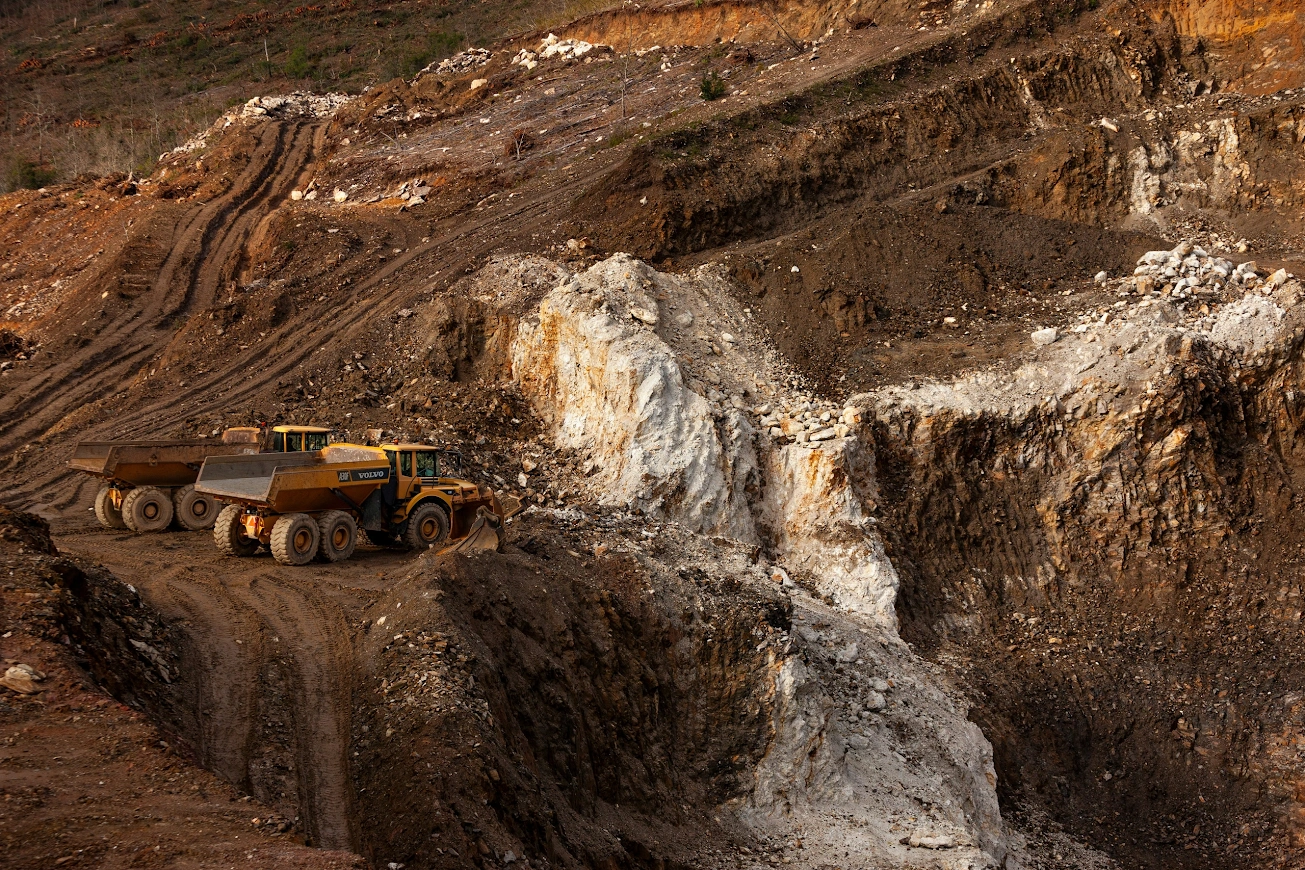The laconic message from Ukrhydroenergo about the destruction of the Kakhovska HPP dam and the inability to restore it conveys no less sadness than Hemingway's shortest story.
The occupiers mock the disaster, calling it "the opening of the bathing season" and an effective way to slow down the advance of the Armed Forces while hundreds of Ukrainians try to save their lives and the lives of animals.
To find out who was involved in the destruction of the dam at the Kakhovska HPP, the Molfar team analyzed all the information available on the network. Four theories were under the consideration: the dam broke by itself ("Mother Nature" is to blame); detonation and self-destruction; the Ukrainian military is to blame (although they did not have access to the HPP from the beginning of the full-scale invasion) and the thesis that the Russians blew up the HPP themselves. Let us consider each of them in detail.
Was the terrorist attack on the Kakhovska HPP a long-planned provocation by the Russians?
We wrote about Russian preparations for provocations at the Kakhovska HPP in October last year. After all, then the Russians started pushing their propaganda, saying that "the Ukrainians are planning to blow up the hydroelectric power station." The Institute for the Study of War wrote about this Russian plan, in particular.
The Ukrainian side has also repeatedly emphasized that the Russians are preparing a provocation at the Nova Kakhovka dam, which could threaten a man-made catastrophe: : this was written by Podolyak in his Twitter account, President Zelenskyi said during his address to the European Council.
The consequences were seen by Ukraine and the world only on 6-th of June. Of course, someone, like the UN, did not want to hear and see about the disaster, because they were busy celebrating the day of the Russian language.

The Russians' answer did not take long, because it was ready according to the template — Ukraine and the Armed Forces were blamed for the disaster at the Kakhovska HPP. About the fact that "not everything is so clear-cut" and it is still necessary to figure out who is to blame, because this dam "collapsed itself" was picked up by pseudo-positional Russian mass media, such as mass media projects.
But this is typical rhetoric of Russian so-called "oppositionists", which, in principle, is predictable. But what was really strange was that Bellingcat investigators joined the spread of Russian propaganda about the "self-destruction" of the dam.
Bellingcat investigators tweet that the dam was destroyed by “Mother Nature”
Of course, within a few minutes, this tweet was deleted.
The Russian mass media managed to instantly pick up on this thesis, because it is perfectly woven into the canvas of their propaganda: "everyone is to blame, but not us."
Why is it not "Mother Nature" or the self-destruction of the dam?
On May 21, 2023, the water level rose at the Kakhovskaya HPP dam, the maximum indicator was 17.54 m. Prior to that, in 2016-2022, the water level did not exceed 17 m.
A few days before, on 05/05/2023, the Russian mass media reported on the increase in the water level at the dam. This was explained by the discharge of water from hydroelectric power stations in the Dnipro and Zaporizhzhia, as well as strikes by the Armed Forces of Ukraine on the dam (although before that, the last strikes were recorded in November 2022). But, according to the Secretary of the National Security Council Oleksiy Danilov, the Russians themselves raised the water level.
Then, at the hydroelectric power station, water was discharged in that part of the dam through open shunts in that part of the dam that became the likely epicenter of the breach on June 6, while Russian sources reported the risk of a dam breach and separate cases of flooding of Russian military positions.
Referring to experts, NYT journalists indicate that in case of excessive load from the water mass, the collapse of the dam should begin in the area near the shore, while, as in the case of the Kakhovska HPP, the epicenter was the central part.
Could it be a partial self-destruction of the dam, which led to the detonation of the previously mined dam by the Russians?
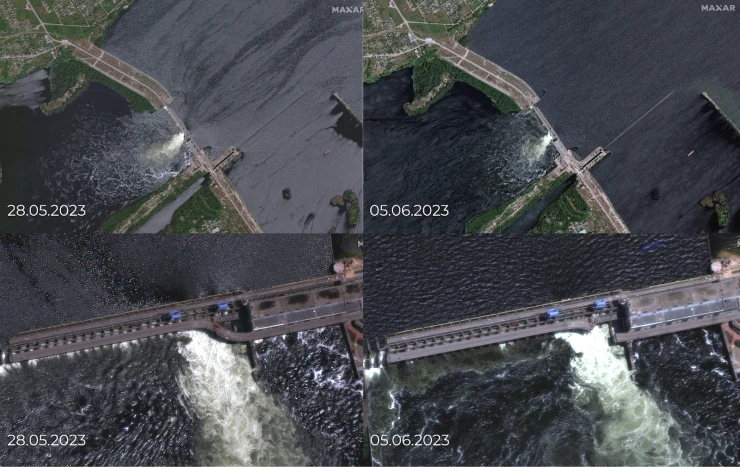
According to Maxar satellite images dated 05/28/2023 and 06/05/2023, water was being discharged through the probably damaged emergency sluices of the dam, because, as we wrote above, its level rose to 17.54 m.
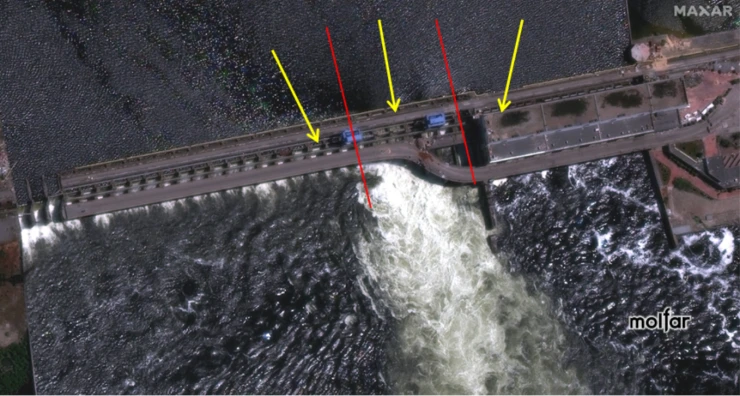
Due to the fact that the water flowed through the specified section of the dam for a long time, the main pressure of the water flow reached the supports in the place where the water passes, as well as to the left of the passage and in the area of the western part of the administrative building, located on the right.
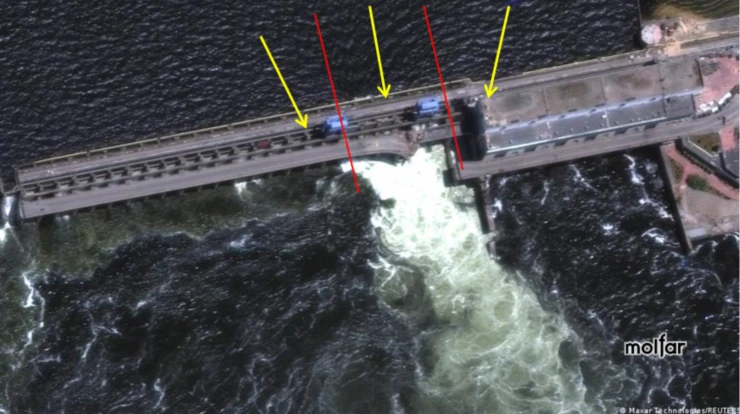
Next, we can see that the picture from 05/28/2023 shows a damaged section of the road in the area of water leakage from the dam. In the picture from 06/05/2023, she is no longer present at all.
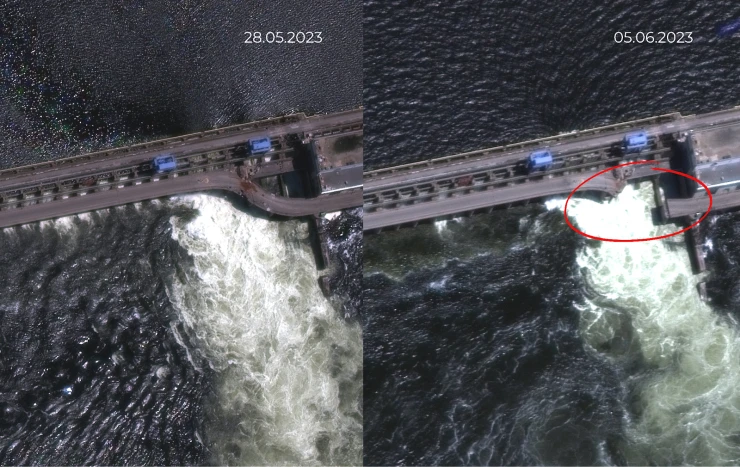
Next, let's watch this video. In it, with the help of TNP-1 TOD, the damaged dam was filmed, as well as the explosion. We can see the administration building to the right of the dam, which, as of 06/06/2023 at 2:46 a.m., was intact after the damage to the dam. The main flow of water was through the damaged section of the dam to the left of the building.
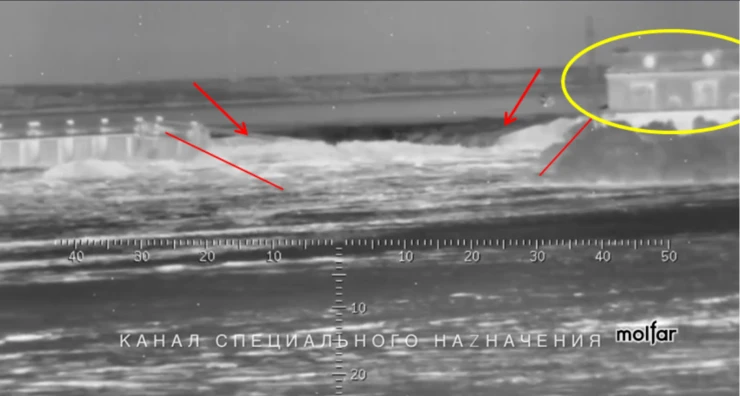
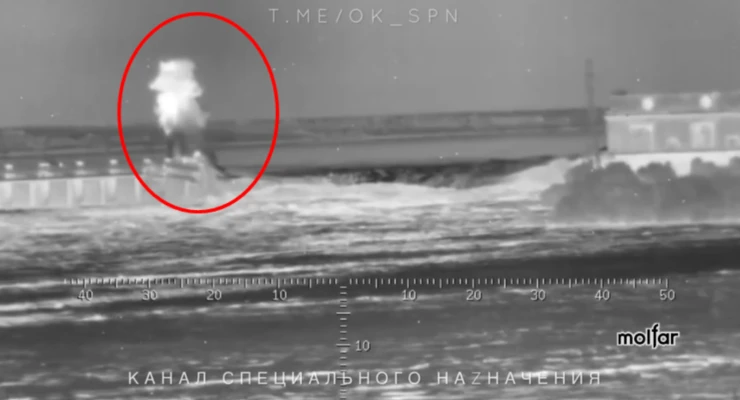
While watching this time-lapse video, no "arrival" of objects that could precede the explosion was detected. That is, the explosive device detonated during contact with the flow of water.
In another video from the drone, we can see that the flow of water passes through the destroyed section of the dam previously filmed at 2:46, which could have damaged the foundation of the administrative building and caused it to subside.
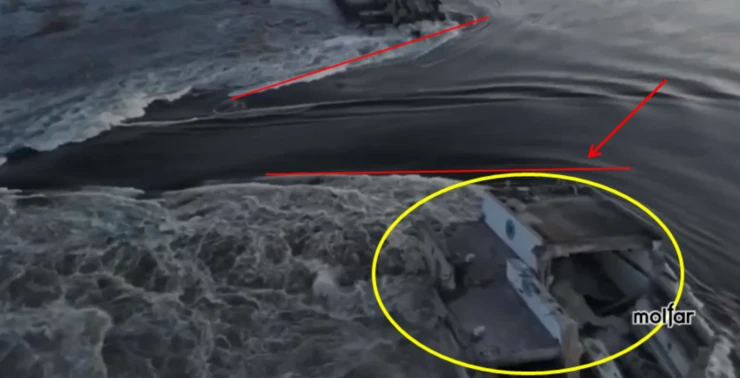
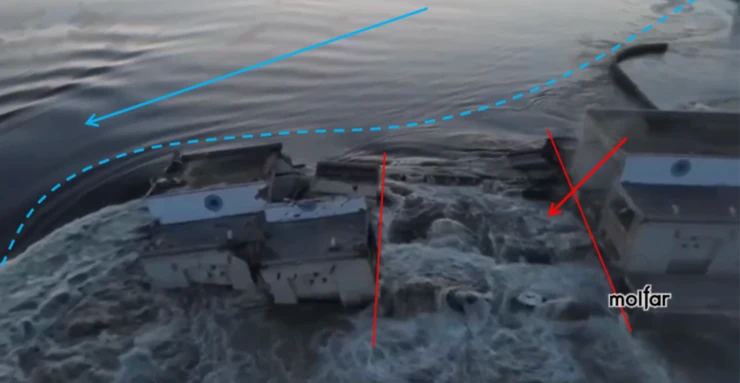
The destruction of the foundation supports was possible if the uncontrolled flow of water passed under the administrative building. Because the foundation supports at the location of the administrative building are wider than the supports at the dam collapse site.
Damage to the building and the foundation, filmed on video, is possible in the event of the activation of explosive devices.

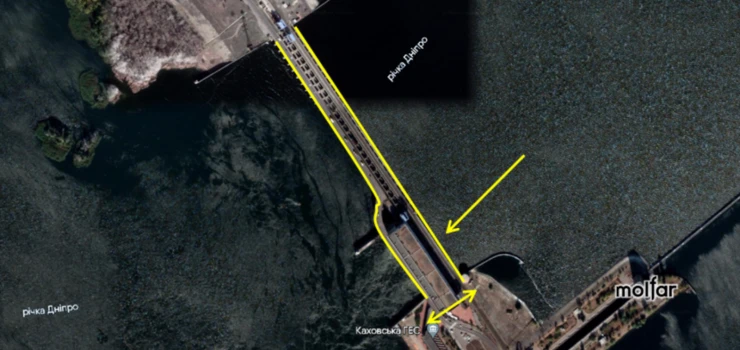
At the time the video was filmed, the area of the dam was not flooded.
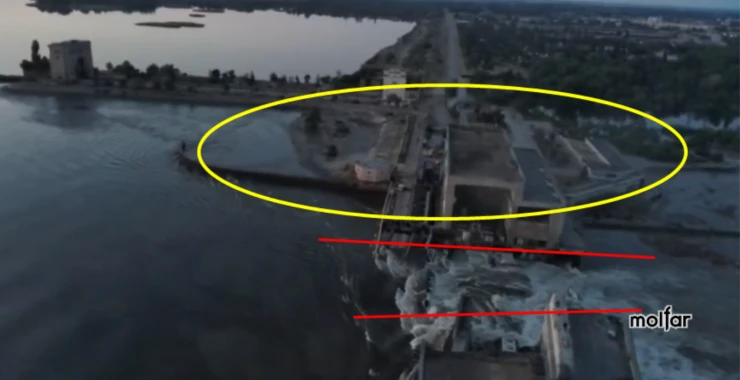
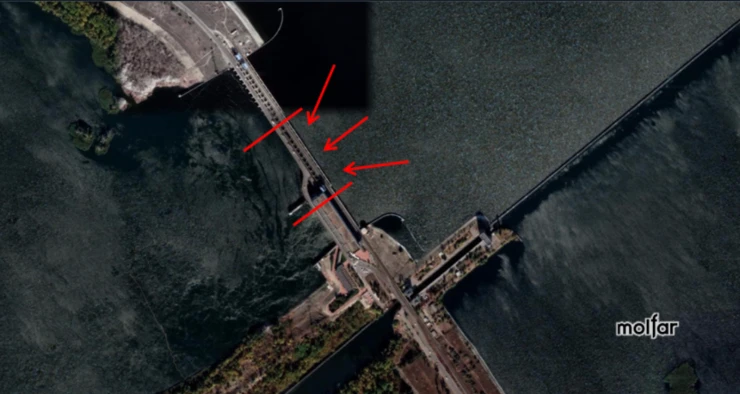

This part of the dam was flooded due to the detonation of explosive devices that came into contact with the water.
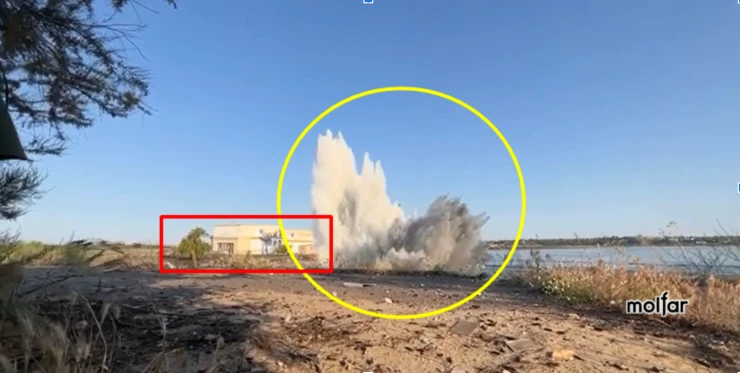
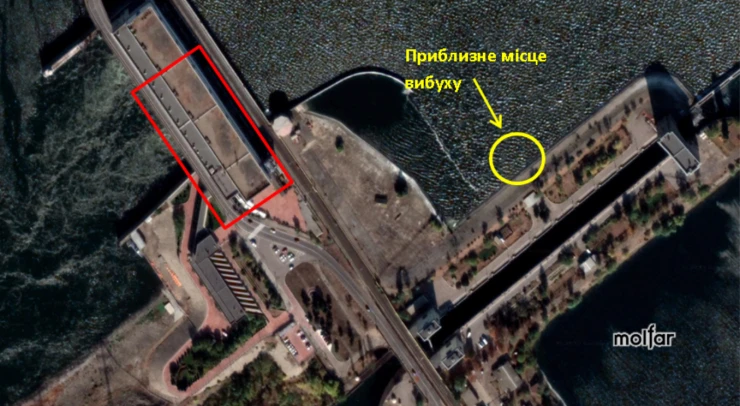
Previously, according to a similar scenario, in order to slow down the advance of the Ukrainian military, on 05/25/2023, Russian troops damaged the dam of the Karliv Reservoir.
Next, we will consider the hypothesis about the destruction of the dam by the Ukrainian military and why it is impossible. Even from a technical point of view.
The version about the involvement of the Ukrainian side in blowing up the HPP: chronological and factual inconsistencies
Kakhovska HPP was occupied by the Russians practically from the first days of their full-scale invasion of Ukraine. The Armed Forces of Ukraine did not have access to the dam, as well as to the HPP itself, since that time.
the Russians began to discuss the probable detonation of the Kakhovska HPP in the fall of 2022, when the Ukrainian Armed Forces de-occupied the right-bank Kherson region. At the time, they noted that a massive strike was needed to destroy the dam, during which many missiles would be used at the same time.
The BBC reported in October 2022 that an extremely large amount of explosives would be required to destroy this dam, following the example of the Antoniv bridge, which had previously been shelled by our armed forces for a long time in order to cut the Russian logistics artery.
Important: the destroyed part of the dam is ~200 m long. The Russian mass media wrote that the attack was allegedly carried out by the Armed Forces of Ukraine with the "Vilkha" anti-aircraft missile system. And as if from that blow, the valves, which are supposed to regulate the discharge of water, were destroyed, but the dam itself was not damaged.
The combat part of "Alder" is 170-250 kg. At the same time, individual hits of GMLRS rockets (warhead — 90 kg) and 155-mm artillery shells (warhead — 22 kg) caused only limited damage to the structures, damaging only the surface layer.
In order to destroy the construction of the Kakhovska HPP, dozens of tons of correctly placed explosives are needed, according to the comment of the head of the State Development and Construction Agency, Kyrilo Budanov, that is, to destroy the dam with the help of the “Vilkha” MLRS, which was published in the Russian mass media and pro-Russian TG channels, which has a warhead mass of only 250 kg is impossible.
At the same time, the military Telegram channel reported on the alleged arrival of the HPP on June 6, 2023 at 02:35, which destroyed part of the structure. And after that, under pressure, the following destructions began. But unlike the autumn strikes of the Armed Forces of Ukraine on the Antonivsky Bridge, this time the Russian side did not provide any confirmation of the shelling. And the version with "Alder" was submitted only 6 hours after the dam broke. But the occupiers are somewhat inaccurate in time — on the evening of June 6, the Russian mass media reported that numerous shelling from the "Vilkha" took place at 02:00 and led to the destruction of the upper part of the dam.
According to the publication of the NYT publication, local residents heard the sound of the explosion at 02:50.
But there are many more coincidences in the version about the involvement of the Russians in undermining the dam. We will consider them below.
Why are the Russian occupiers to blame for the destruction of the Kakhovska HPP dam? Chronology
We assume that before the detonation of the dam at the HPP, the 1st motorized rifle battalion as part of the 205th MSBr. This was also said by Mykhailo Podolyak, adviser to the head of the OP.
In the telegram channel of the 205th MSBr, there was a post about the withdrawal of Russian troops to the left bank of the Kherson region, and it was noted that the dam was mined for detonation, if the armed forces start an uncontrolled, from the point of view of the occupiers, advance and in the event that they enter Kherson. The author also estimated the probability of the Russians blowing up the dam at 70%. Separately published (1, 2) recommendations for Kherson residents in the event of a dam blow-up.
At 12:43 p.m., a post was published in the VK group "205 OMSBR" that the 205 brigade "heroically" distinguished itself on June 6, and some of the soldiers were presented for state awards. The author of the post noted: "I can't say what our guys did, but I think everyone reads the news."
13.10.2022. The Russian TG channel "76th Guards Airborne Assault Division" published a satellite image of the Kakhovka hydroelectric power plant dam with the following caption: "These are the three crossings where our defense is still holding. The Kakhovka dam is the only thing that saves us. Air defense forces cannot protect the combat capability of our group."
October 21, 2022. The TG channel of the 205th Brigade published a post about the entry of Russian troops into the left-bank part of the Kherson region, and noted that the dam was mined to blow up if the Armed Forces of Ukraine had uncontrolled advance and entry into Kherson. The author also estimated the probability of Russians blowing up the dam at 70%. In October, the Main Directorate of Intelligence of the Ministry of Defense of Ukraine indicated that the mining was carried out in April 2022, and in October, the locks and supports of the hydroelectric power plant were also mined, and trucks with explosives were located on the dam itself. Then, three days later, on 10/23/2022, the 205th Brigade's TG channel posted recommendations (1, 2) for Kherson residents in case the dam was blown up.
On October 24, 2022. The website republic.ru published an interview of Ukrainian military expert Roman Svitan, which he gave to the former Russian journalist of "Channel 1" Farida Kurbangalieva (currently, according to media reports, Farida is an independent journalist who writes about Ukraine's resistance to Russian aggression). In an interview, the journalist asked the question "how likely is it that the Russian military will blow up the Kakhovska HPP?" Svitan says that the Russians may blow up the dam to slow down the advance of the Armed Forces towards Russian-occupied Crimea.
Later, on November 9, 2022, against the background of information that the Russians are leaving Kherson, and Ukrainian troops are liberating the city, there was a post on the Russian telegram channel in which the authors of the post clearly indicated that the dam was mined.
On November 10, 2022, the late Russian military correspondent Vladlen Tatarsky published a post on his TG channel with the caption: "The Kakhov Dam must be blown up after the retreat. I hope they are going to do it." This publication was reposted by a number of pro-Russian TG channels (1, 2, 3, 4, 5).
December 21, 2022. A video of a conversation with a mercenary of the criminal PMK "Wagner" and a Chechen militant was made public on the YouTube channel of the Ukrainian blogger "Edgar Myrotvorets". In the course of the conversation, the occupiers themselves reported that the Kakhovska HPP was mined by Russian military personnel and that they planned to blow it up: "...on January 1, the Kakhovska HPP will be blown up and everything will be destroyed by the Armed Forces...". Confirmation of the presence of militants of the "Wagner" PMC on the territory of the city of Nova Kakhovka is a photo of the militant, published on April 28, 2023, on the Russian social network VKontakte.
On May 6, 2023, another Russian military officer of the Izvestia TV channel, Dmitriy Astrakhan, reposted the publication of the collaborator Andriy Dvoretsky on the TG channel, in which he notes that blowing up the dam is unprofitable for the Armed Forces against the background of a future counteroffensive, and the Armed Forces in this case may lose 2-3 potentially profitable positions for the construction of crossings on the Dnieper. At the same time, the post indicated beneficial consequences for the Russian occupiers of blowing up the Kakhovka HPP: "...at least for three days, the activity of the enemy downstream from Kakhovka will decrease (with the exception of disturbing DRGs on boats), which will reduce the active front to 157 km to the edge of Kinburnska braids and will allow the Armed Forces of the Russian Federation to transfer reserves to the east. After the water recedes, the artificial rasputitsa will be preserved for a long time in the previously flooded territories."
An important observation: on May 30, 2023, i.e., a week before the dam was blown up, the Russian government approved a resolution according to which until January 1, 2028, technical investigations of accidents at hydrotechnical structures that occurred as a result of military operations, sabotage and terrorist activities should not be conducted in the occupied Ukrainian territories Acts
June 6, 2023. Yehor Guzenko is a citizen of the Russian Federation, a terrorist of the unrecognized "DPR" (as of November 2022, he was part of the 125th regiment of the defunct "DPR"), who is currently in the occupied territory of the Kherson region. In his telegram channel, he published several video appeals (1, 2, 3), where he indirectly admitted the involvement of the Russians in blowing up the Kakhovska HPP. He said that the detonation of the hydroelectric power station would greatly complicate the offensive of the Armed Forces of Ukraine in the direction of Kherson and noted that if the evacuation of the Russian military from the islands is successful, "then it is possible to blow up all the dams, damn it, on the Dnieper, only for good."
Before that, Guzenko published his photo against the background of the Kakhovska HPP with military trucks behind. According to Huzenko, at the end of March, his group was transferred to KakhovskaHPP as a PPD. During the following months, the occupier published photos and videos (1, 2, 3, 4) near and directly in the premises of the HPP. He later denied that Russia had carried out the bombing. And then he wrote about the possibility of destroying the northern dams on the Dnieper on the territory of the Russian Federation and Belarus.

In another publication with a video, where the process of launching a reconnaissance copter was filmed, Guzenko added the post: "Let's fly and see how the hohols are sinking." The telegramchannel "Otryady kadyrovtsev" published a post with a video from reconnaissance drones with the post "crests are running in panic from their positions near Kherson. Nazis save their skins by striking from the islands to Kherson, but our brothers do not leave them a chance! Our fighters are fighting with artillery and drones while running away! The Khokhly send all new vessels to evacuate their fighters, but they are all at our fingertips! Now the Ukrob*s will not be able to recover for a long time after such a defeat!”
These theses lead to the conclusion that the Ukrainian military was not ready for such a development of events, which can also confirm the absence of the intention of the military leadership of Ukraine to blow up the Kakhovska HPP dam.
On the same day, June 6, after the beginning of the disaster, other facts of the involvement of the Russians in undermining the dam began to appear on the Internet. As it is, one of the Russian soldiers published this video from the place of the breakthrough. According to him, "there were no arrivals."
There are videos (1,2,3) from the place of the breakthrough and with the sounds of explosions on the Melitopil telegram channel. Outside the camera, the voice of a military man can be heard: "something is exploding there, in short, underwater several times." Later, the same channel publishes a photo of what are probably anti-tank mines washed ashore.
Several posts(1,2,3,4) about the detonation of the dam appear in the Russian TG-channel "AP Wagner". The author writes that the hydroelectric power station was blown up: "But at night some kind person put a charge and the dam was like that." Among the pluses, kh*khol will become more difficult to force the Dnipro".
In the morning, after the blow-up of the hydroelectric power plant, pro-Russian journalist and propagandist Yuriy Podoliaka stated on his TG channel that there were no strikes on the dam during the night.
At noon, a post was published in the VK group "205 OMSBR" that the 205 brigade "heroically" distinguished itself on June 6, and some of the soldiers were presented for state awards. The author of the post writes: "What was done by our guys, alas, I can't say, but I think that news is read all over."
In the evening, the independent physicist Richard Cordaro said on Twitter that the explosion at the dam in Nova Kakhovka was probably also recorded by the magnetometer in Romania. The explosion at this time was also recorded according to infrasound analysis. He noted that this could have been preceded by a series of uniform explosions with the same temporal amplitude.
The townspeople also wrote about a series of uniform explosions in online discussions. For example, in the TG-channel “HOT ➔ NOVOKAHOVSKY” under the post about the explosion of the Kakhovska HPP, one of the users noted in the comments that there was a series of explosions there. Under another post of the same channel, users noted that the explosion was heard 20 km away, and that the dam was blown up by the Russians. Journalist Kostyantyn Ryzhenko's TG channel had a message that "according to the analysis of the video, the HPP was blown up from the middle, no rocket or artillery could have caused such damage."
Who could be involved in undermining the dam?
The occupying 205th MSB is part of the 49th combined army of the Southern Military District. Their permanent location is Military Unit 74814 (Budennovsk, Stavropol Territory, Russia). Probably, the 1st motorized rifle battalion of this brigade could have been involved in the undermining of the Kakhovskaya HPP dam.
Deanon of some members
— Oleg Makarevich Leontiyovych
(Makarevich Oleg Leontyevich, born on December 30, 1962) is a colonel general. Probably, it was he who could give the order to blow up the dam.

— Shchukin Vladimir Yuriyovych. 13.08.1994 — Inst. In 2019-2020, he was the commander of the reconnaissance platoon of the 205 brigade. As of 2023, he is participating in the war (perhaps as part of another unit).
— Artur Akhmedov — VK. He identifies himself as the commander of the 205th brigade branch, signed up to dating communities in northern Crimea near Novaya Kakhovka.
— Shokolda Denys Viktorovych —VK,OK — a serviceman of the "Storm" assault unit of the 205th brigade. He is an active member of the VK group "#Апанасенковцы 205 OMSKB", which is engaged in collecting rubber aid for the Kherson region. He is probably the administrator of the TG channel "ZOV Kursavka", which published confirmations of their stay in the Kherson region (1,2,3).
We conclude
The flooding of the Kakhovka hydroelectric power plant occurred because the Russians occupied it from the first days of the full-scale invasion and had uninterrupted access to it. Then they mined it, and then deliberately increased the water pressure, which led to the destruction of the dam and its supports. As a result, they destroyed the dam.
The Russian leadership knew about the planning of the terrorist attack and the approaching disaster and prepared the legislative basis for itself. Why is it beneficial for the Russians to blow up the dam — to slow down the offensive of the Armed Forces — the occupation military correspondents themselves said. And also the fact that the dam was not destroyed by the Armed Forces, because the Ukrainian military was not ready to blow up the dam — this is confirmed by the occupiers with their slanderous theses.
Currently, it is still difficult to analyze the explosion of the Kakhovska HPP completely in the historical context to understand the cause-and-effect relationships. But let's remember that armies that go on the offensive do not blow up dams to block their way to advance. Instead, it is the retreating armies that take such actions to slow down the other side's advance.
If you have any further questions about this investigation or would like more detailed information, please email us at: [email protected]




